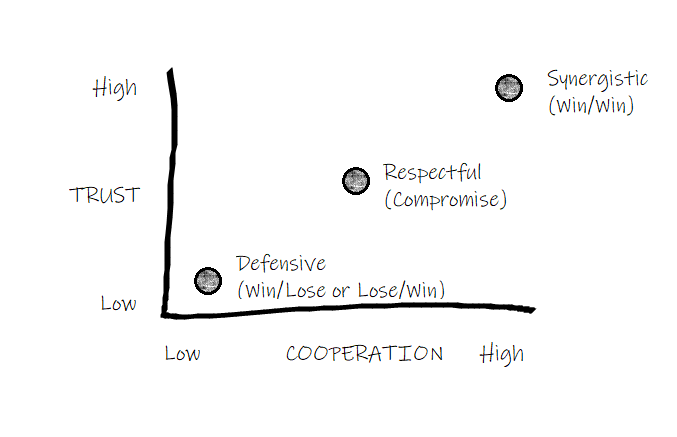Maybe you’ve heard the phrase “the whole is greater than the sum of its parts”. That’s actually what Habit 6: Synergize from The 7 Habits of Highly Effective People: Powerful Lessons in Personal Change is all about. Let’s dive into it to see what that means.
The previous habits covered in the book prepare us for the concept of synergy. You know you are in a synergistic environment when you know the ideas and results are better than could have been produced by any individual participating. It’s an exciting experience, teetering on the edge of chaos. The group feeds on the excitement and momentum, and by being open to and building on the ideas generated – even if the ideas weren’t their own – great results occur.
Have you ever been in an environment like this? You know if you have because it’s very memorable. If you haven’t, I hope that you will soon experience it. Even though sometimes the synergistic experience is spontaneous, there are a few prerequisites to create the environment that will foster synergy.
Valuing the Differences
The essence of synergy is to value differences – to respect them, to build on strengths, to compensate for weaknesses.
Stephen Covey
The 7 Habits of Highly Effective People
It takes a fair amount of humility to approach an interaction with the intention to ‘value the differences’. Our ego doesn’t want to be wrong, does it? We want to have the right answer, the best idea, and be smart (or the smartest). But in order to value the differences, we need to know that the experiences and knowledge of others, leading to perhaps a different perspective, are as valuable as our experiences and knowledge that has led to our perspective. If we can both value the differences, then we can learn and create cooperatively.
You begin with the belief that parties involved will gain more insight, and that the excitement of that mutual learning and insight will create a momentum toward more and more insights, learnings, and growth.
Stephen Covey
The 7 Habits of Highly Effective People
Both Habit 4, Think Win/Win, and Habit 5, Seek First to Understand, Then to Be Understood come into play here. We have to be open to the idea of there being a better solution, a Win/Win solution, than any of the solutions the parties involved are coming to the table with. And, we need to be open to the ideas of others. But courage also is needed because we need to open ourselves up. We can’t be defensive or protective of the status quo if we want to experience synergy.
Where synergy can’t thrive
It might be helpful in understanding synergy to look at where synergy can’t survive. Covey mentions several (unfortunately common) actions that undermine attempts at creating synergy: “confessing other people’s sins, politicking, rivalry, interpersonal conflict, protecting one’s backside, masterminding, and second guessing”. When people go into an interaction with a Win/Lose or Lose/Win mindset, synergy can’t thrive. He also mentions insecurity driving people to get others to come around to their way of thinking because “they don’t realize that the very strength of the relationship is in having another point of view.”
Trust and Cooperation
Covey provides this diagram which illustrates the different levels of communication:

- Low Trust/Low Cooperation: this type of communication is characterized by “defensiveness, protectiveness, and often legalistic language, which covers all the bases and spells out qualifiers and the escape clauses in the event things go sour.”
- Medium Trust/Medium Cooperation: this type of communication is characterized by respect and politeness. The parties respect each other, but don’t listen with empathy. That is, they don’t listen with the intent to understand. Many times this will result in compromise. As Covey puts it, 1+1 = 1½ in this situation because both parties give and take.
- High Trust/High Cooperation: this is where the synergistic communication takes places. While compromise may produce less than the sum of its parts, “synergy means that 1+1 may equal 8, 16, or even 1600.”
How do you create an environment to produce synergy?
Covey doesn’t say directly how to create the synergistic environment, but he gives a lot of examples. In each example where he was called in to help two parties come to an agreement, he first started by teaching on Habits 4, 5, and 6. My takeaway is that we have to be aware of what Win/Win, Seek First to Understand Then to Be Understood, and Synergy mean before we can embark on creative cooperation in the hopes of finding ‘the third alternative’. This makes sense, doesn’t it? How can we expect to facilitate a meeting where we want synergy to occur if the participants don’t even know the principles that make synergy possible? Once the concepts are presented, then the participants can choose to set an intention of striving for synergy.
tl;dr
Synergy hinges on valuing the differences of the participants in an interaction. By keeping an open mind and exhibiting high trust, creative cooperation can take place. And when this happens, “the whole is greater than the sum of its parts”.
engineer your life
- Read Habit 6 in The 7 Habits of Highly Effective People: Powerful Lessons in Personal Change by Stephen Covey.
- Now that you have a name for it, think about interactions in the past that may have exhibited synergy. If you can think of one, what made that synergy possible?
- Think about an upcoming interaction that would benefit from synergy. What needs to be true in order for the environment to support synergistic communication?